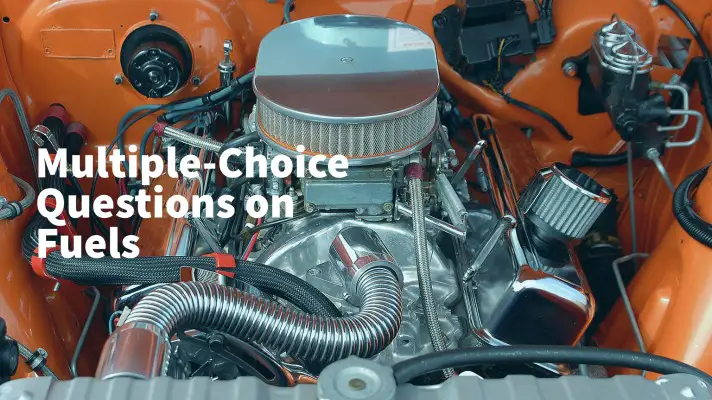In this article, I will keep some Multiple-Choice Questions on Fuels that will help you in examinations and also in viva.
Also, there will be a Quiz test of 10 marks on Fuels. Appear for the test and know how much depth you have in this topic.
At the end of this article, you will also find a PDF downloadable button from where you can download the PDF format of this MCQ sheet. So now let’s start the objective-type questions or viva questions.
MCQ questions or Viva Questions on Fuels

- By which one of the following instrument, you can measure the calorific value of gaseous fuels?
- Bomb Calorimeter
- Boy’s gas calorimeter ✔
- Both of the above
- None of the above
- By which one of the following instrument, you can measure the calorific value of solid and liquid fuels?
- Bomb Calorimeter ✔
- Boy’s gas calorimeter
- Both of the above
- None of the above
- Which one of the following relationship is true?
- L.C.V.= H.C.V.+ 9H2 X 2466
- H.C.V.= L.C.V.- 9H2 X 2466
- L.C.V.= H.C.V. + 2466
- H.C.V.= L.C.V.+9H2 X 2466 ✔
- Which one of the following gas is known as town gas?
- Coal gas ✔
- Water gas
- Producer gas
- None of these
- The unit of calorific value is:
- Kj
- kJ/ kg ✔
- J / Kg.K
- J/ K
- H.C.V. of a fuel can be determined by:
1. Kelvin’s law
2. Boiler’s law
3. Avogadro’s formula
4. Dulong’s formula ✔
- Which one is true for a fuel?
- H.C.V > L.C.V. ✔
- H.C.V. = L.C.V.
- H.C.V. < L.C.V.
- Can’t say.
- Mainly, the fuel consists of:
- Oxygen and hydrogen
- Hydrogen and sulphur
- Carbon and hydrogen ✔
- Oxygen and sulphur
- The average calorific value of wood is:
- 12700 Kj/kg
- 19700 Kj/kg ✔
- 22700 Kj/kg
- 30700 Kj/kg
- Which one of the following fuels have highest calorific value?
- Bituminous coal ✔
- Lignite coal
- Peat
- Wood
- Which one of the following is the first stage in the formation of coal?
- Bituminous coal
- Lignite coal
- Peat ✔
- Wood
- The average calorific value of Peat is:
- 20,000 kJ/kg
- 15000 kJ/kg
- 23000 kJ/kg ✔
- 33000 kJ/kg
- The Lignite coal contains ____% of Carbon.
- 40
- 60 ✔
- 80
- 95
- The calorific value of Anthracite coal is:
- 30000 kJ/kg
- 32000 kJ/kg
- 36000 kJ/kg ✔
- 42000 kJ/kg
- For making the soft coke, carbonisation of coal is carried out at:
- 600 Degree C. ✔
- 300 Degree C.
- 900 Degree C.
- 1000 Degree C.
Quiz Questions on Fuel
Here is the Quiz for you. It will be better for you if you read the Overview first and then appear for the Quiz Test.
Overview
All fuels contain a certain amount of energy. We can get this energy by burning this fuel. The total energy released by any fuel is termed as higher calorific value or H.C.V.
Depending on the physical state of the fuel, it can be classified into three groups:
- Solid fuels
- Liquid fuels
- Gaseous fuels
These fuels can be made by human beings or it can be available in nature.
Solid fuels
Wood, peat coal, bituminous coal, lignite coal, coke, pulverised coal are the solid fuels.
Wood is mainly comprised of carbon and hydrogen. The calorific value of wood is 19700 kJ/ kg.
While processing the coal, the first substance found is named peat. It contains approximately 30% of water. Before using the peat coal, it should be dried. The calorific value of it is 23000 kJ/ kg.
During the processing of coal, the substance found in the second stage is termed lignite coal. It contains approximately 40% moisture and the balance of 60% is carbon. The calorific value of lignite coal is 25000 kJ/kg.
During the processing of coal, the substance found in the third stage is termed bituminous coal. It contains approximately 5% moisture and 85% carbon. The calorific value of it is 33500 kJ/kg.
At the last stage during the processing of the coal, we get Anthracite coal. It contains approximately 90% carbon. Its’ calorific value is 36,000 kJ/kg.
If you heat the coal at a very high temperature continuously for 40-50 hours in the absence of air within a closed vessel, you will get a coke. This process of getting coke is termed as carbonization of coal. Coke contains approximately 85 to 90% carbon.
If the carbonization of coal is done at 500 to 700 degrees C. The resulting coke is termed soft coke. If the carbonization of coal is performed at 1000 degrees C, it is termed as hard coke. For domestic applications, soft coke is used whereas hard coke is required in a blast furnace.
While powdering the low quality coal, the pulverised coal is produced.
Liquid fuels
Liquid fuels are procured from natural petroleum or crude oil. Crude oil is naturally available at the earth’s crust. If you boil the crude oil at different temperatures, you will get different forms of liquid fuels such as petrol, paraffin oil, kerosene, fuel oil, lubricating oil, etc.
Petrol is distilled at a temperature 65 degree C to 220 degree C.
Kerosene is distilled at a temperature of 220 degree C to 345 degree C.
Comparison between solid fuels and liquid fuels
Liquid fuels have higher calorific value than that of solid fuels.
But the liquid fuel involves greater risk of fire.
From the liquid fuels, we get higher efficiency.
Gaseous fuels
The fuels used in gaseous form are coal gas, producer gas, water gas, coke oven gas, blast furnace gas, etc.
Coal gas or town gas is comprised of hydrogen, carbon monoxide, and different types of hydrocarbon. By carbonizing the coal, you will get coal gas. The calorific value of coal gas is 21000 to 25000 kJ/m2. This is used in lighting and heating systems in streets and towns.
By partial combustion of the coal, producer gas is obtained. The manufacturing cost is low. This is used in glass industries, and in power plants.
Water-gas is burnt with a blue color flame. Hence, it is termed as blue water gas. This is used in welding industries and in furnaces.
While producing pig iron in the blast furnaces, blast furnace gas is produced as a by-product. This gas is used as fuel in power generation industries and in steelworks. Its calorific value is 3750 kJ/m2.
During the carbonization of the bituminous coal, coke oven gas is obtained. The calorific value of this gas is from 14500 to 18500 kJ/ m2. This gas is used in heating power generation industries.
Advantages and dis advantages of gaseous fuel
There is no chances of solid and liquid impurities in gaseous fuels.
For complete combustion, the gaseous fuels require less amount of air.
The gaseous fuels can directly be used in combustion engines.
Main problem in gaseous fuel is that it requires large storage capacity and they are inflammable.
Why do you require good fuel?
A good fuel should have the following characteristics:
Low ignition point
High calorific value
No harmful gases should be produced
Easy to store and transport
Least quantity of smoke and gases should be produced
Calorific value of fuels
The amount of heat produced in the complete combustion of 1 kg of fuel is termed as calorific value of that fuel.
Calorific value can be classified into two categories:
Higher calorific value and lower calorific value.
Higher calorific value is the gross calorific value and lower calorific value is the net calorific value.
Every fuel contains hydrogen. When the fuel is heated, the hydrogen in it gets heated and reacts with oxygen. Then converted into steam. This heat that converts hydrogen and oxygen mixture into water, should be considered in case of gross or higher calorific value.
When you subtract this heat from the high calorific value, you will get lower or net calorific value.
L.C.V= H.C.V –Heat required to convert hydrogen into steam.
Latent heat of vaporization of water at a standard temperature of 15 degree C is 2466 kj//kg.
L.C.V= H.C.V- Ms*2466 kJ / kg.
Ms = mass of steam formed (kg)/ 1 kg of fuel = 9x H2.
Conclusion
I hope that the Multiple-Choice Questions on Fuels will help you in your college/university examinations and in different types of competitive examinations. I will be more encouraged if I get feedback from your end. Please don’t forget to give the feedback by writing in the comment box. Good Luck!


